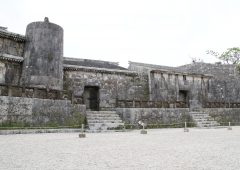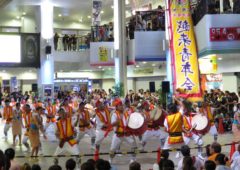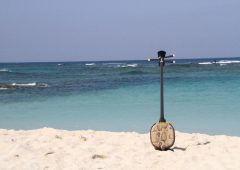2016.07.10
Performing arts of the Ryukyus are spreading throughout world
By Hoshin Nakamura
Instructor
NPO Okinawa Language Center
Ryukyu karate, music and dance were created, evolved and performed by the island people for hundreds of years. The Ryukyu performing arts have become so popular that masters of karate, music, and dance have been invited to countries on every continent to entertain the peoples there. But what makes Ryukyu performing arts attractive to audiences overseas?
In the 14th century, the Ryukyu Kingdom traded with Japan, Korea, China and Southeast Asian nations. These nations had various self-defense martial arts that had often been developed from forms and movements of animals in fights, such as cats, snakes, monkeys, cocks, etc. The ancient people learned how to attack and defend themselves from the strategies of these animal fights.
Ryukyu karate
In 1429, Hashi, the great chieftain from Sashiki, unified the divided kingdoms of the Ryukyus to bring about peace. In 1478, King Sho Shin banned weapons of all classes. As a result, the kingdom’s people enjoyed 131 years of peace, prosperity, and longevity.
As a means of self-defense, “tii” was developed combining various types of self-defense on the basis of “Tuu-dii” (Chinese hand). After the Satsuma invasion, “tii” became “Uchinaa tii” that means Okinawan hand. The term ‘hand’ means a martial art. In the 18th century, different types of “tii” were developed into “Naafa-tii,” “Sui-tii,” and “Tumai-tii”, Naha-hand, Shuri-hand, and Tomari-hand respectively.
In the 20th century, the Ryukyuan martial arts came to be known as “tii” meaning the “hand”. It was only in 1912 that Ryukyuan “tii” began to be called “karate” meaning “empty hand”. In 1938, Dr. Hironori Otsuka founded “Wadoo-ryu” karate that was recognized as an independent style of karate.
Originally there were no such thing as “ryu” or “school”, which had been a Japanese idea of “clique” or “batsu”. In the Ryukyus, the term “tii” was enough no matter where it was practiced. The “ryu” or “do” as in Uechi-ryu, Shorin-ryu, Karate-do, etc. began to appear only after the Japanese cultural influence. Consequently, such styles of karate schools as Shorin-ryu, Matsubayashi-ryu, Shotokan-ryu, Kojo-ryu, Goju-ryu, Shuri-ryu, Uechi-ryu, Wado-ryu appeared.
The major techniques of Ryukyuan karate consist of blocks, kicks, punches, sanes, strikes, throws and joint locks. Important katas (forms) are Sanchin, Saifaa, Seiunchin, Seipai, Seisan, Sanseinui, Tensho, Kururunfa, and Suparenpai.
Gichin Funakoshi is the founder of Shotokan-ryu, and regarded as the “Father of Modern Karate”. Kanryo Higaon’na is the founder of Naha-tii; Shoshin Nagamine is the founder of Matsubayashi-ryu adapted from Shuri-tii and Tomari-tii in 1947. Choshin Chibana founded Shorin-ryu in 1933, which came from a Chinese temple called “Shao Lin”. Kanbun Uechi is the founder of Uechi-ryu while Chojun Miyagi founded Goju-ryu.
Today, Okinawan karate schools (dojo) have been built and spreading in many nations. International karate tournaments have been held periodically. Yu Kiyuna became the world champion in 2014 and 2015. Many overseas students of Ryukyu karate come to Okinawa in order to experience the true spirit of Ryukyu karate. Below are some reasons why the Ryukyu karate has become internationally recognized and accepted.
- Ryukyu karate is used not for fighting but only for self-protection.
- Ryukyu karate masters don’t brag about their skills but embrace the spirit of courtesy and compassion.
- They don’t look down upon others but seek for mutual respect.
- They are always caring and engaging in self-discipline.
- They are peace-minded and don’t kill the attackers or offenders who also have their beloved family.
- Ryukyu karate masters protect the weak and the needy.
- Ryukyu karate is a humanistic and ethical martial art.
- Ryukyu karate masters value ideals of international peace and friendship.
Music and dance
The Ryukyuan musical scale, which is called pentatonic, consists of five notes, namely Do, Mi, Fa, So, and Ti. The Ryukyuan songs and poems are composed of 30 syllables. “Tinsagu-nu Hana” (Balsam Flower) is a typical example whose first verse goes as follow:
Ti-n-sa-gu-nu ha-na ya (8) (Just as my finger nails are tinted)
Chi-mi-sa-chi ni su-mi-ti (8) (With the pigment of balsam flowers)
Wa-n-na-ch-ru u-ya-ya (8) (I tint my heart)
Wa-n-du mi-a-ti (6) (With the precepts of my parents)
The song or verse is sung accompanied by traditional musical instruments. The main Ryukyu musical instruments include string, percussion, and wind instruments. Sanshin (3-stringed), kokyu (2-stringed), and koto (13-stringed) are the popular string instruments; drum, paarankuu, sanba, yotsudake, and symbal are common percussion instruments; yokobue (bamboo flute) and hora (tilton sea shell) are the main wind instruments.
Ryukyu dance and music with instruments are often performed simultaneously, and classified into classical/court, folk, drama, miscellaneous, and creative categories. For example, Kajadifu is classical; Tanchame is folk, Hatoma-bushi is miscellaneous; Warabigami is creative. After the Meiji invasion, many Ryukyu dance schools (ryuha) emerged, such as, Tamagusuku-ryu, Oyadomari-ryu, Miyagi-ryu, and the like.
Tokyo Ryukyu Dance Association was established by the Ryukyuans living in Tokyo. The 7th performance of Ryukyu music and dance was held in May 2016. Fifteen schools in Tokyo offered 26 dances that were performed to the accompaniment of classical, miscellaneous, and creative music.
Like Ryukyu karate schools, many Ryukyuan schools of music and dance have been established overseas today. The Ryukyu performing arts share common values built upon universal peace, friendship, brother-sisterhood as well as the spirit of “Ichariba choodee” that means “Whoever you happen to meet and talk is like your brother and sister.”




 2024.07.07
2024.07.07 2024.07.02
2024.07.02 2024.06.11
2024.06.11 2024.06.03
2024.06.03 2024.05.02
2024.05.02 2024.04.26
2024.04.26 2024.04.04
2024.04.04 2024.04.02
2024.04.02 2024.03.03
2024.03.03 2024.02.26
2024.02.26






